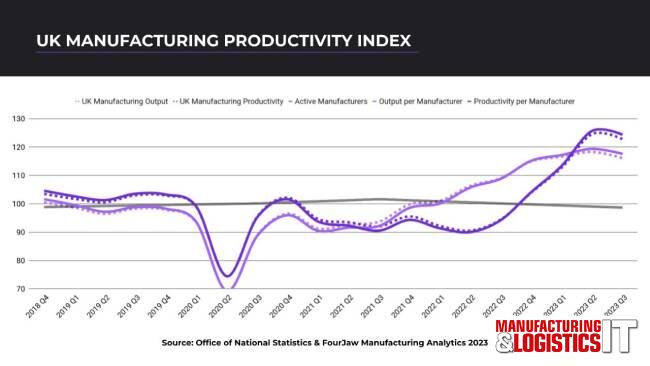The UK manufacturing sector was 6.6% more productive in the third quarter of 2023 than the same period in 2022, driven primarily by improvements in the automotive and broader transport equipment sector, according to analysis of ONS data from FourJaw Manufacturing Analytics, a technology company that measures machine productivity.
FourJaw’s analysis, which informs its UK Manufacturing Productivity Index, shows that this productivity boost was worth £9.4bn to UK manufacturers and continued a run of improved manufacturing output and productivity going back to 2021.
- The total value of UK manufacturing output in the third quarter of 2023 was £152.4bn. Although this was £9.3bn more than the same period in 2022, it was £2.9bn lower than Q2 2023 – the first quarter-on-quarter reduction in manufacturing output since the start of 2021.
- Year-on-year improvements in output and productivity were achieved despite the number of active UK manufacturers falling from 138,000 to 136,000 in the same period. Output per manufacturer increased by 8.0% between Q3 2022 and Q3 2023, while productivity per manufacturer was up 8.2%. On average, each active UK manufacturer produced goods worth £1.12m in Q3 2023, up from £1.04m the year before.
- The motor vehicles and transport equipment sector achieved the most significant year-on-year improvements. Output in Q3 2023 was £5.3bn higher than in Q3 2022, supported by a 19.7% increase in productivity worth £5.1bn across the sector.
- The food production and electronics (computer, electronic and electrical products) sectors also significantly improved output and productivity. Food production achieved a 6.2% productivity gain year-on-year worth £1.4bn, while electronics delivered a 9.8% productivity improvement worth £1bn to the sector in Q3 2023.
Chris Iveson, CEO at FourJaw Manufacturing Analytics, comments: “Manufacturers face significant challenges and uncertainties right now. However, many do so from a position of strength, having delivered improvements in output and productivity over the last two years.”

“The value of UK manufacturing output has soared post-pandemic. Some of this is inflation, which reached almost 20% for goods leaving factories last year. Once we adjust for that, we see manufacturers achieving incredible productivity improvements in 2022 and 2023.
“Order books have been growing from domestic and international markets, and we’ve seen manufacturers re-shore work that was outsourced overseas. That’s filled previously underused production lines, led to investment in new machines and factory expansion, and driven greater use of smart technologies to find additional capacity within existing production lines.
“There are many reasons to be cheerful. Automotive has rebounded well after addressing supply-chain issues, and aerospace companies are enjoying their largest order books ever. Despite this, manufacturers are understandably cautious and looking for ways to boost agility and productivity without investing in additional assets.”
Methodology
FourJaw’s data team analysed a range of data provided by the Office of National Statistics (ONS) to create a rolling five-year picture of output and productivity for the whole UK manufacturing sector and at the subsector and company level. Sources included the ONS’s index of production and producer price inflation datasets, and UK business activity, size and location statistical bulletins. Productivity levels were calculated by reducing the value of output figures by the corresponding inflation rate. Company-level figures are averages, based on the value of output and productivity per assumed active UK manufacturer at the time.



